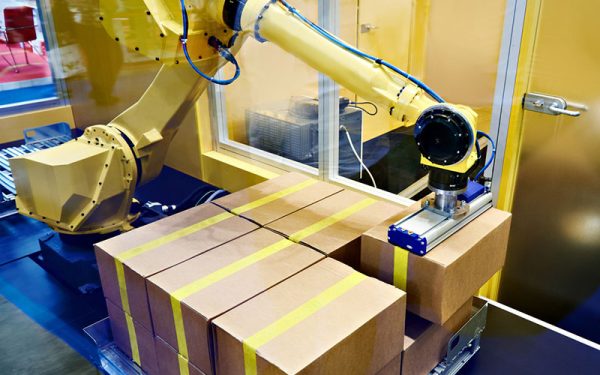Introduction: Closing the Loop with Automation
In manufacturing and distribution, the final step of production palletising plays a critical role in packaging, logistics, and overall efficiency. Manual palletising can be physically demanding, inconsistent, and a bottleneck for high-throughput operations. Robotic palletising offers a scalable, precise, and cost-effective solution to automate this task, ensuring reliable stacking, reduced labour strain, and consistent throughput at the end of the production line.
What Is Robotic Palletising?
Robotic palletising involves the use of an industrial robot arm to pick, orient, and place items typically boxes, bags, or products onto a pallet in a pre-programmed pattern. The system is designed to handle high volumes of repetitive pallet stacking with minimal human input, offering both speed and accuracy.
A standard robotic palletising setup includes:
- A 4 or 6-axis robotic arm
- A specialized end-of-arm tool (vacuum gripper, clamp, or finger-style gripper)
- A conveyor or infeed system delivering items
- Sensors or vision systems for part detection and positioning
- Pallet dispensers or slip-sheet handling systems

The Impact of Robotic Palletising in Industry
Automating palletising improves ergonomics, throughput, and consistency while reducing operational cost and physical strain on human workers.
Increased Throughput
Robots can perform continuous stacking operations without fatigue or performance loss. They operate at predictable speeds and handle heavy loads with ease, making them ideal for high-volume production lines. Their ability to work 24/7 increases output without requiring overtime labour.
Consistency and Quality
Robotic palletisers place items in uniform, repeatable patterns reducing the risk of uneven loads, overhangs, or instability during transit. This consistency ensures better cube utilization, reduces damaged goods, and simplifies downstream processes like wrapping and shipping.
Labour Safety and Efficiency
Palletising tasks often involve bending, twisting, and lifting leading to repetitive strain injuries or fatigue. By automating this step, companies reduce risk, improve workplace safety, and free personnel to focus on supervision, machine operation, or quality control.
Space Optimization
Compact robotic palletising cells can often fit into existing lines or tight floorplans. They eliminate the need for large mechanical systems or excessive manual space, making them suitable for both new facilities and retrofits.
Adaptability to Product and Pattern Changes
Modern robotic systems can be quickly reprogrammed to adapt to different pallet patterns, product sizes, or stacking configurations. This is especially useful for operations that package multiple SKUs or need to switch between box sizes throughout the day.
Real-World Applications
- Food and Beverage: Stacking cartons, crates, or shrink-wrapped goods for cold storage and shipping
- Pharmaceuticals: Palletising boxes with serialized labels for traceable shipping
- Consumer Goods: Handling retail-ready packaging for bulk delivery to stores
- Agriculture: Bag palletising for fertilizers, seeds, and feed in rugged environments
- E-Commerce Fulfilment: Stacking mixed packages from automated picking lines.
These examples highlight the diversity of use cases across logistics, warehousing, and manufacturing sectors.
Integration with Existing Systems
Robotic palletisers can be integrated with ERP or warehouse management systems to receive order data, verify SKUs, or report pallet completion. Barcode scanners, weight checks, and vision inspection systems can be added for quality control.
Pallet dispensers, stretch wrappers, and conveyors can also be linked for a fully automated end-of-line system.
Custom End-Effectors
Grippers are often customized for the type of product being palletised:
- Vacuum Grippers: For sealed boxes or rigid surfaces
- Clamp Grippers: For heavier or compressible items
- Finger Grippers: For open crates, trays, or irregular shapes
Some systems feature multiple grippers or tool changers to handle different product types within a single cycle.
Software and Pattern Flexibility
Most systems allow operators to build and store multiple palletising patterns using intuitive interfaces. Changes can be made without reprogramming the robot manually, enabling rapid adjustments for seasonal SKUs or packaging updates.
Patterns can be designed for:
- Interlocking strength
- Maximum pallet height or weight
- Mixed layers of different box sizes
This flexibility supports dynamic operations and multi-product lines.
Robotic palletising provides a reliable, safe, and scalable way to automate a traditionally manual task. By combining precision, repeatability, and flexibility, these systems enhance end-of-line performance across a wide range of industries. As production demands grow and labour constraints tighten, robotic palletising offers a future-proof solution that delivers immediate and long-term gains.
